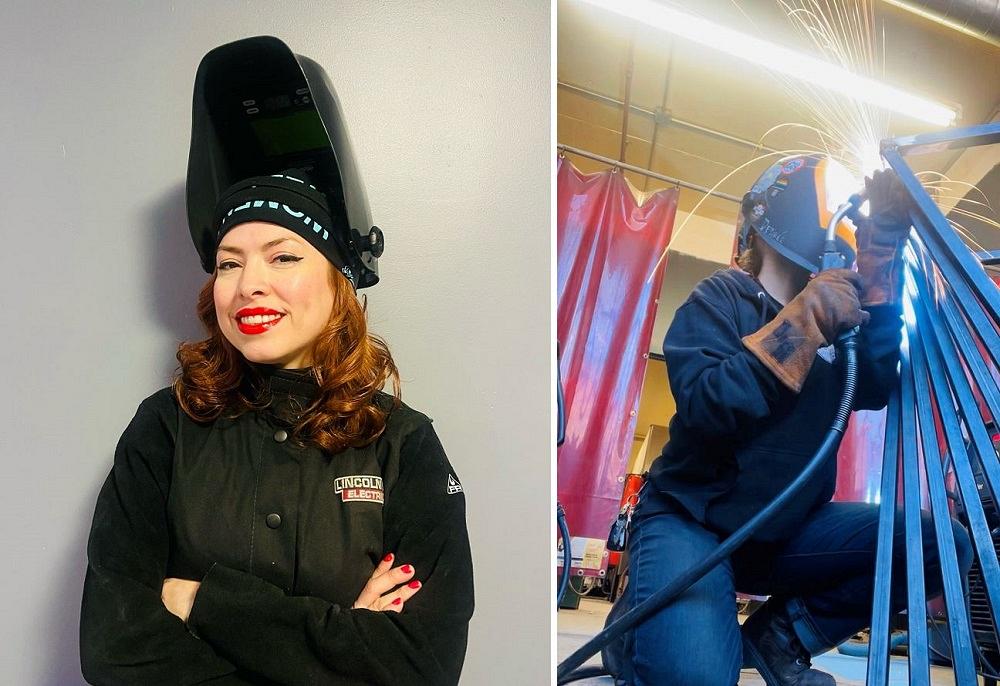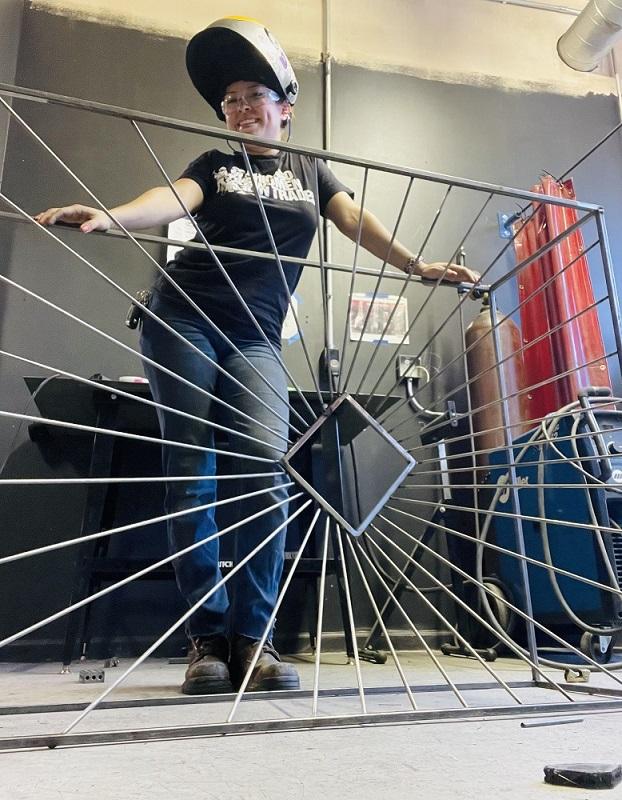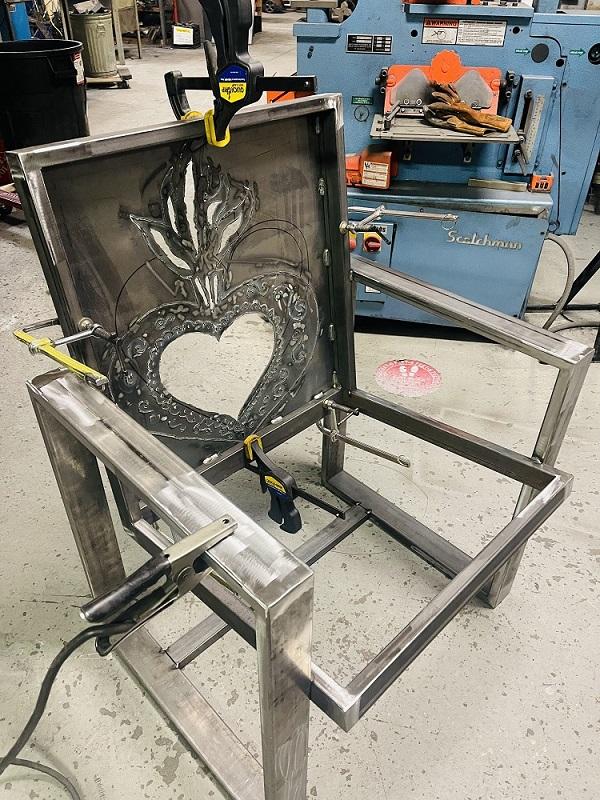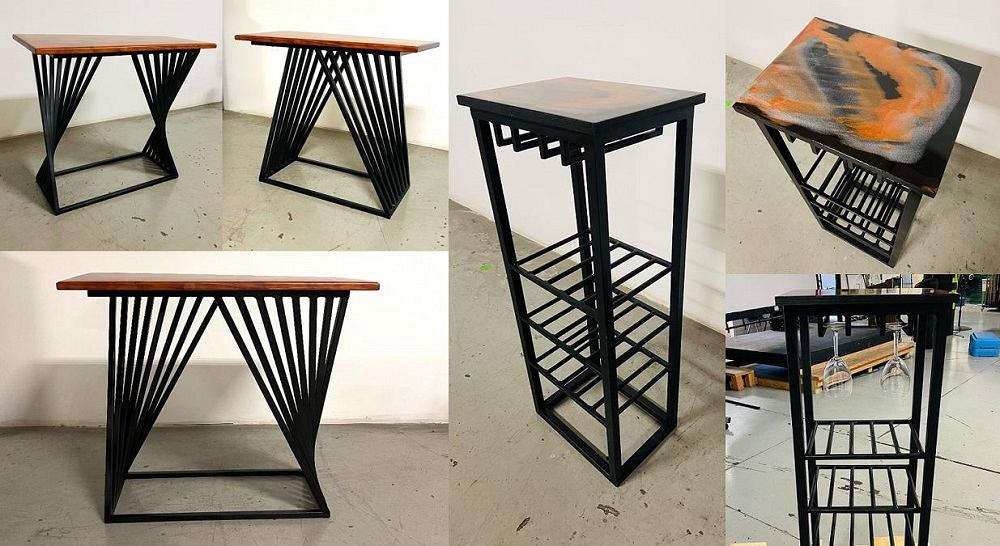Editor
- FMA
- The Fabricator
- FABTECH
- Canadian Metalworking
Categories
- Additive Manufacturing
- Aluminum Welding
- Arc Welding
- Assembly and Joining
- Automation and Robotics
- Bending and Forming
- Consumables
- Cutting and Weld Prep
- Electric Vehicles
- En Español
- Finishing
- Hydroforming
- Laser Cutting
- Laser Welding
- Machining
- Manufacturing Software
- Materials Handling
- Metals/Materials
- Oxyfuel Cutting
- Plasma Cutting
- Power Tools
- Punching and Other Holemaking
- Roll Forming
- Safety
- Sawing
- Shearing
- Shop Management
- Testing and Measuring
- Tube and Pipe Fabrication
- Tube and Pipe Production
- Waterjet Cutting
Industry Directory
Webcasts
Podcasts
FAB 40
Advertise
Subscribe
Account Login
Search
A welding instructor’s career path to working with metal
Chicago welding instructor weighs in on career, women in welding, and furniture fabrication
- By Rafael Guerrero
- March 12, 2024
- Article
- Arc Welding

Since leaving her cubicle job, Desirée Guzmán has spent more than a decade working with metal. Currently she is a welding instructor for Chicago Women in Trades, a nonprofit workforce development initiative. Images: Desirée Guzmán
Years ago, Desirée Guzmán became fascinated by cold connections and how this process joined pieces of metal together without heat.
It only made sense that sooner or later she would become curious about other methods to join metal.
“The natural segue was it led me to be curious about welding,” she said.
That curiosity took a hold of Guzmán. She learned how to weld and worked fabrication jobs that required long days and strenuous tasks, which led her down a career path that she and others likely didn’t see coming.
Nowadays, Guzmán teaches aspiring women welders at Chicago Women in Trades’ welding program, the same program where she learned to weld.
“It's been really awesome to come full circle, to have gone through the program and to now be back and be able to assist other women to enter the field and prepare them, and know firsthand what they're experiencing and dealing with,” she said.
A Fascination With Metal
Working with metal was not in Guzmán’s plans originally. She graduated from college with a degree in public policy, making her one of the first in her family to earn a college degree. An internship led to a full-time job; however, it wasn’t long before she realized that a job in a cubicle was not for her.
A chance encounter with a jewelry maker while on vacation in Puerto Rico changed her trajectory forever. Guzmán said she was amazed at how this woman made jewelry out of metal.
“I was fascinated by her because she had like a steel block on her knee and a hammer, and she was making jewelry,” Guzmán recalled. “She was bending wire and smacking it on the steel block on her knee. And I was like, ‘What are you doing? How long have you been doing this?’
“I just picked her brain. I was there 10 days, and I probably visited her five times,” she said.

Guzmán said she became fascinated with metal following a chance encounter with a jewelry artist while on vacation in Puerto Rico. Eventually, her curiosity with how heat affects metal led her to welding.
Guzmán returned to Chicago a changed person, she said. She bought tools, began to experiment with wire, and cut shapes into sheet metal. She went into trial-and-error mode, challenging herself to do more and more.
“It was so fascinating that I couldn’t stop,” she said.
Guzmán set up a small jewelry business called Mano y Metal (Hand and Metal) and sold handmade metal jewelry at festivals, events, and pop-up shops in the Chicago area and shipped it to customers worldwide. Though she no longer runs the business, it ignited her fascination with heat’s role in metalwork, which ultimately led to an interest in learning how to weld.
Learning and Teaching
Guzmán could have started welding sooner than she did, but she kept putting it off.
“Honestly, I didn't think I could, and I was intimidated by it. It can be very intimidating, and that's what I want women not to feel,” she said. “I held myself back from doing welding for a couple of years, where I convinced myself for different reasons why it wasn't for me.”
Chicago Women in Trades provided a unique approach to welding that appealed to Guzmán. The nonprofit’s Women in Welding program is a free course where students learn the main welding processes, shop math, shop safety, blueprint reading, and workplace readiness; earn American Welding Society MIG certification and OSHA certification; and get assistance in areas like job search and resumes, postgraduation case management, and physical strengthening.
About 10 to 12 women graduate the program every 10 weeks, ready for jobs, Guzmán said.
“The wide range of jobs available to them ranges from just welding to metal fabricating to manufacturing to union jobs—the women lead all types of really cool paths afterwards,” she said.
After completing the program in 2019, Guzmán worked in fabrication for about three years at a variety of places including an aluminum company, a seating company, and an electrical company. She started off as a MIG welder, working with stainless steel, aluminum, and carbon steel. Guzmán earned additional AWS certifications along the way and started learning how to TIG weld on her own during lunch breaks and after work. Over time, she grew more comfortable reading blueprints and improved her fabrication and tool usage skills.
But the Chicago Women in Trades’ mission appealed to Guzmán, and she returned as an instructor in 2022.

After completing the Chicago Women in Trades’ welding program, Guzmán worked in metal fabrication for a few years before shifting into teaching.
Being on the other side of the classroom has allowed her to mentor students and share her experiences. One student, Michelle Velez, a former pharmacy technician who took the welding course, got a job at a Chicago studio where she does “a little bit of everything” in fabrication, including welding, thanks to the help from Guzmán and Chicago Women in Trades.
Velez said students were provided with everything they needed, including welding equipment, PPE, well-being checks, and tutoring. Guzmán, meanwhile, was always there ready to help, to prepare them for things like final projects and certification, and to provide positivity.
“It never felt like a class. It was more fun, the whole experience. When the class ended, nobody wanted to leave,” Velez said of the welding course.
“I just wish there were more teachers like her,” she added.
Guzmán said she can relate to many of her students because some have taken an unorthodox path to welding. Some may end up in shops where they’re the only woman around. Some find that their work is scrutinized more just because of their gender, race, ethnicity, or physical strength. Others are trying to prove to friends and family that welding is the right choice for them.
“A lot of the women that join our program have always been interested in this but have been, for one reason or another, held back,” she said. “We have them just push forward with what they want to do, despite not possibly having a support system to do it. Our program acts like a bridge.
“There is space for women to enter the field, and we're welcome there, despite what the norms are,” she said.
A Valuable Skill
After more than a decade of working with metal in some form or another, Guzmán remains fascinated by it.
She favors carbon steel due to its resiliency. When she’s TIG welding, Guzmán likes to work with stainless steel because of the colors it can generate. She also likes to work with aluminum because it's lightweight and durable, even though it’s difficult and requires patience and care.
“I gradually got more and more interested in metal and fascinated by its resiliency, how you can be tough with it, put it through a lot of stress, hammer it, put it through fire, cut it, and it emerges resilient,” she said about metal. “It's really strong and essential in our society.
“Welding will definitely test you in all types of realms,” she added. “It forces you to slow down and take your time and also push through your own frustration when things aren't working out.”
Her love for metalwork stretches beyond Chicago Women in Trades. Guzmán is also into building furniture —tables, chairs, wine carts, you name it.
Velez said she’s worked with Guzmán on a few pieces of furniture for their respective homes; the two also made pieces for a Chicago Women in Trades silent auction. Velez noted some of the tables, chairs, lamps, and other pieces of furniture Guzmán built.
“She always finds something that looks easy, but then when you go do it, the project becomes challenging and frustrating,” Velez said.
A few examples of Guzmán’s furniture projects include:
- A table fabricated from 14-ga. square steel tubing. She cut each piece at a different angle so they would fit flat up against the top and bottom bases. She spaced each piece apart but increased the space between each leg to create the illusion of twisting.
- A wine cart with a 16-ga. square steel tube frame. She used 3/8-in. steel rod for the shelf racks to prevent the wine bottles from rolling around.
- A steel-frame chair with a plasma-cut sacred heart design on the back.
Guzmán said she likes fabricating furniture because it allows her to get creative.
“I like the illusion of bending metal. When metal is cold, you can't bend it, right?” she said of her furniture decisions. “But I like the illusion of it. It looks like it's twisting, looks like it's moving. It looks like there's dimension to it.”
Would she like to be a small business owner again, this time making furniture instead of jewelry? She didn’t rule it out.
“I do like to make furniture pieces on the side, either for commission, for organizations, or for myself,” Guzmán said. “But it’s just on my free time, whatever free time is.
“Will I return to entrepreneurship? I think so, especially since with welding, you can take it anywhere and to any part of the world,” she added. “Things always need to be built.”About the Author

Rafael Guerrero
2135 Point Blvd.
Elgin, IL 60123
(815)-227-8242
Rafael Guerrero. was named editor of The Welder in April 2022. He spent nine years as a journalist in newspapers in the Midwest and Pacific Northwest, covering topics and communities in central Illinois, Washington, and the Chicago area.
About the Publication
subscribe now

The Welder, formerly known as Practical Welding Today, is a showcase of the real people who make the products we use and work with every day. This magazine has served the welding community in North America well for more than 20 years.
start your free subscription- Stay connected from anywhere

Easily access valuable industry resources now with full access to the digital edition of The Fabricator.

Easily access valuable industry resources now with full access to the digital edition of The Welder.

Easily access valuable industry resources now with full access to the digital edition of The Tube and Pipe Journal.
- Podcasting
- Podcast:
- The Fabricator Podcast
- Published:
- 04/16/2024
- Running Time:
- 63:29
In this episode of The Fabricator Podcast, Caleb Chamberlain, co-founder and CEO of OSH Cut, discusses his company’s...
- Trending Articles
Sheffield Forgemasters makes global leap in welding technology

ESAB unveils Texas facility renovation

Engine-driven welding machines include integrated air compressors

How welders can stay safe during grinding

The impact of sine and square waves in aluminum AC welding, Part I

- Industry Events
16th Annual Safety Conference
- April 30 - May 1, 2024
- Elgin,
Pipe and Tube Conference
- May 21 - 22, 2024
- Omaha, NE
World-Class Roll Forming Workshop
- June 5 - 6, 2024
- Louisville, KY
Advanced Laser Application Workshop
- June 25 - 27, 2024
- Novi, MI




























